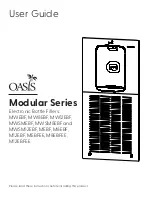
Top climate system
with LUBING Touch Controller
Copyright © Lubing System - All rights reserved
29
5.5.2 Pressure switch/sensor
A pressure switch is installed in the pump units (switching point 25 bar). If the signal from
the pressure switch is missing after the set waiting time, the controller outputs the error
message “No water alarm” and stops the system.
Pump units with frequency converter are equipped with a pressure sensor instead of a
pressure switch, which additionally gives a signal for speed control.
5.5.3 Thermo valve
A thermo valve is installed in the pump units to drain hot water from the pump in the
event of a fault. Cold fresh water flows in and thus counteracts overheating. The switching
temperature is 60°C. During normal operation no water may escape. If the valve drains hot
water, this indicates a fault in the system.
5.5.4 Additional fan
An additional fan is only integrated in pump units with frequency converter (Vario). This fan starts with the pump
and continues to run for a few minutes after the pump has been switched off.
5.6 Further system components
5.6.1 Pressure relief
An electrical pressure relief system releases the pressure from the high-pressure lines immediately after the pump
unit is switched off. The high-pressure solenoid valve is controlled by the LUBING Touch Controller. Due to the
rapid drop in pressure, dripping of the nozzles is almost impossible.
In normal operation only a small amount of water is drained within a few seconds after the pump unit has stopped.
An increased volume may indicate a defective main valve or air in the pipes. If water also escapes while the pump
is running, this indicates, for example, a defect in the high- pressure valve (e.g. due to wear).
5.6.2. High pressure nozzles
The high-pressure nozzles ensure extremel
y fine atomization of the injected water
at pressures above 50bar. They consist of the nozzle body (1), the spring valve (2),
the bolt (3) and the nozzle head (4).
Cleaning:
Blocked nozzles or nozzles with poor spray pattern can be unscrewed and disassembled. If the nozzle is calcified,
it might be cleaned in a descaling bath / acetic acid bath / ultrasonic bath. Afterwards rinse thoroughly and blow
out.
In case of frequent problems with the nozzles due to calcareous or ferrous water, water treatment should take
place.
If it is observed that brass nozzles are not sufficiently resistant (e.g. chemically), they should be replaced with
stainless steel nozzles.
lubingsystem.
com
lubingsystem.
com
lubingsystem.
com
lubingsystem.
com
lubingsystem.
com
lubingsystem.
com
lubingsystem.
com
lubingsystem.
com
lubingsystem.
com
lubingsystem.
com
lubingsystem.
com
lubingsystem.
com
lubingsystem.
com
lubingsystem.
com
lubingsystem.
com
lubingsystem.
com
lubingsystem.
com
lubingsystem.
com
lubingsystem.
com
lubingsystem.
com
com
lubingsystem.
com
lubingsystem.
com
lubingsystem.
com
lubingsystem.
com
lubingsystem.
com
lubingsystem.
com
lubingsystem.
com
lubingsystem.
com
lubingsystem.
com
lubingsystem.
com
















































